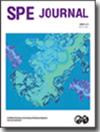利用印度孟买近海盆地 Bassein 地层的高分辨率电阻率图像进行纹理分析,从而确定和量化异质碳酸盐岩储层中的孔隙度系统的方法
IF 3.2
3区 工程技术
Q1 ENGINEERING, PETROLEUM
引用次数: 0
摘要
在评估 Bassein 地层的孔隙度系统时,使用了高分辨率电阻率图像(FMI)数据。从 FMI 数据中观察到的主要特征是存在长度和厚度不同的低角度裂缝和溶解通道。在具有极低密度中子孔隙度的地层中,溶液通道被视为导电特征。这些充满泥浆的溶蚀通道可以积极参与生产。由于这些孔隙特征的尺度非常小,因此无法从常规测井数据中识别出来。为了定义和量化孔隙度类型,如水井、溶蚀通道和基质孔隙度,需要对电阻率图像数据进行处理,并计算出基于图像的孔隙度。对岩心薄片进行研究,用于校准基于图像的孔隙度系统。利用电阻率图像数据,我们计算出了孔隙度类型,例如孔隙、连通基质和电阻,以及它们对总孔隙度的贡献。通过孔隙度贡献(孔隙度分区)识别储层中的碳氢化合物,可以更好地了解酸作业后正在生产碳氢化合物的低孔隙度层的碳氢化合物生产情况。本文章由计算机程序翻译,如有差异,请以英文原文为准。
An Approach to Define and Quantify Porosity System in Heterogeneous Carbonate Reservoirs through Textural Analysis using High-Resolution Resistivity Image in the Bassein Formation of Mumbai Offshore Basin, India
In evaluating the porosity system of the Bassein formation, high-resolution resistivity image (FMI) data have been used. Major features observed from the FMI data are the presence of low-angle fractures and solution channels of varying length and thickness. Against the layers with very-low-density neutron porosity, solution channels are seen as conductive features. These mud-filled solution channels can actively participate in production. Being very small-scale features, these types of porosities are not identifiable from conventional log data. To define and quantify porosity types such as vugs, solution channel, and matrix porosity, the resistivity image data are processed and image-based porosity is calculated. A core thin-section study is carried out and is used for calibration of the image-derived porosity system. Using resistivity image data, we have computed porosity types, for example, vugs, connected matrix and resistive, and their contribution to total porosity. Identification of hydrocarbons in reservoir layers with their porosity contribution (porosity partitioning) gives better insight into hydrocarbon production in these low-porosity layers which are producing after acid job.
求助全文
通过发布文献求助,成功后即可免费获取论文全文。
去求助
来源期刊

SPE Journal
工程技术-工程:石油
CiteScore
7.20
自引率
11.10%
发文量
229
审稿时长
4.5 months
期刊介绍:
Covers theories and emerging concepts spanning all aspects of engineering for oil and gas exploration and production, including reservoir characterization, multiphase flow, drilling dynamics, well architecture, gas well deliverability, numerical simulation, enhanced oil recovery, CO2 sequestration, and benchmarking and performance indicators.
 求助内容:
求助内容: 应助结果提醒方式:
应助结果提醒方式:


